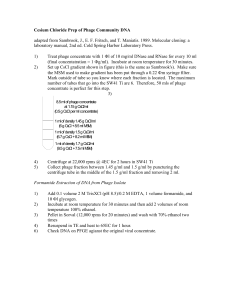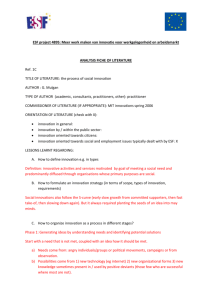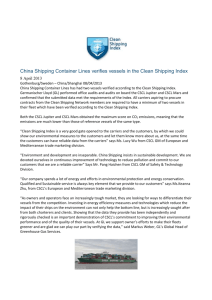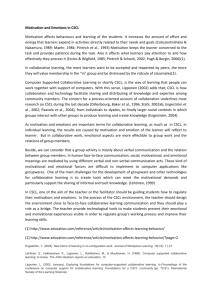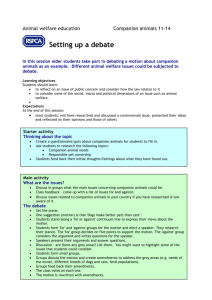lifelong learning companion - 陳德懷Tak
advertisement
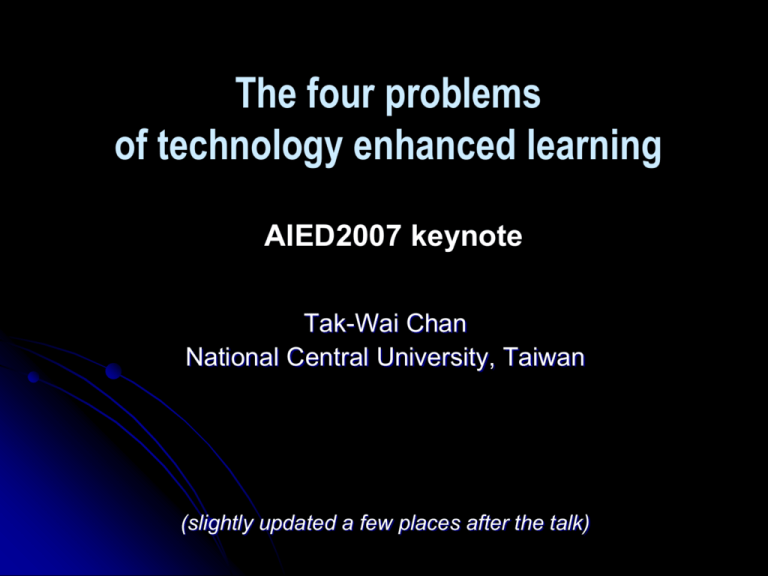
The four problems of technology enhanced learning AIED2007 keynote Tak-Wai Chan National Central University, Taiwan (slightly updated a few places after the talk) Dedicate to John Self! One who inspired a generation of researchers & was a not-yet-known co-founder of the ICCEs! Thanks for my graduate students! To elicit 4 problems that researchers seem to have been trying to resolve in this century! The future is found from the past and the present, especially from the current research communities I notice that the current research communities are working towards 3 orientations; two existed already and one is emerging These 3 orientations are leading to resolving the 4 problems Three orientations of research (Chan, et. al. 2006; Chan, 2006) Dream-based research Adoption-based research exploring the potential implications of some emerging technologies proving the feasibility of spreading our work in the real world practice Humanity-based research developing an individual’s capacity almost entirely from that individual’s perspective cultivating well being of the globe as learners’ value invisible & ubiquitous computing NATURAL PLATFORM context-aware physical environment indoor: smart wall smart desk CYBER PLATFORM outdoor: natural as classroom mobile & wireless devices; wearable computing face-to-face human interaction Internet distance human interaction human computer interaction standalone computers digital manipulative digital toy digital tangibles “The further backward you look, the further forward you can see” Winston Churchill Sidney Pressey’s Teaching Machine in 1920’s Whenever there is a dream, there is a day it comes true! It was not Pressey’s machine, nor was it the first computer in 1946 Was it traditional CAI in 60’s ? Was it artificial intelligence in 70’s ? Was it multimedia and simulation in 80’s ? Was it Internet in 90’s ? Was it mobile & game in 00’s ? This is the Dream-Based Research! Adoption cycle of innovations (Ryan,1948; Rogers,1958; Moore,1991) innovators & visionaries conservatives pragmatists skeptics Innovators Early Adaptors Early Majority Late Majority Late Adaptors Laggards Chasm between innovators & visionaries and pragmatists (G. A. Moore, 1991) pragmatists conservatives skeptics chasm innovators & visionaries Innovators Early Adaptors Early Majority Late Majority Late Adaptors Laggards To cross the chasm –– synergy of technologies Mobile & Game (00’) Internet (90’) Multimedia & Simulation (80’) conservatives Artificial Intelligence (70’) Traditional CAI (60’) skeptics chasm innovators & visionaries pragmatists Early Adaptors Early Majority Late Majority Late Adaptors This is the Adoption-Based Research!Laggards Innovators How long is the time span, 50 or 100 years? What happens after crossing the chasm? Mobile & Game (00’) Internet (90’) Multimedia & Simulation (80’) conservatives Artificial Intelligence (70’) Traditional CAI (60’) skeptics chasm innovators & visionaries pragmatists 2000 Innovators Early Adaptors Early Majority Late Majority 2050 or 2100 Late Laggards Adaptors This is the Humanity-Based Research! More on Humanity-Based Research ‘Humanity’ ? 1. Stressing on individuality individuality is the basis of humanity the very existence of a class is for the sake of an individual the very existence of the learning partners is for the sake of that individual thus, learning is not for the class as a whole, but for an individual optimize individual capacity development Every thing is for the sake of the learner Electronic Books Digital Libraries Computation Museums Content Student Database Community Expensive Equipment Fellow Learners Teachers Cognitive Tools Volunteers Educational Agents Parents ‘Humanity’ ? 2. Learning beyond knowledge acquisition knowledge acquisition is a vehicle for fostering other humanity qualities cognitive, affective, social, attitudinal Beyond knowledge acquisition inner freedom creativity critical thinking (cognitive) passion leadership interest caring (affective) (social) confidence perseverance effort (attitudinal) John Self spelled out this humanity issue: “The defining characteristics of intelligent tutoring systems research: ITSs care,” (Self, 1999) Classical ITS model (Self, 1974) domain knowledge what student model who tutoring strategy how what learner student profile model who tutoring strategy pedagogical model why how communication interface domain knowledge when where who (with) Going beyond knowledge acquisition what learner student profile model who reflective pedagogical student model model why affective how cognitive social attitudinal communication interface domain knowledge when social where who (with) ‘Humanity’ ? 3. Building foundations for the better globe bettering yourself nurturing a caring family incubating a humane society fostering the peaceful and collaborative globe ~ Da-Hseh What are we researchers doing? Dream-Based Research? Adoption-Based Research? Humanity-Based Research? Does AIED / ITS have a dream? Yes, we did Bloom’s 2 sigma problem We still do An extended dream Intelligent Tutoring System (ITS) (Carbonell, 1970) Learning Companion System (Chan & Baskin, ITS1988) Lifelong learning companion (Chan, 2000; Chan, et. al., 2001; Chou & Chan, 2003) baby: learning companion as a magic cradle small kid: learning companion as a toy pupil: learning companion as a pet teenager: learning companion as a peer adult: learning companion as a mentor elder: learning companion as a pet My animal companions – “Disneyficating the learner” My-Pet-Our-Pet Telling the owner how to improve My-Pet’s attributes My-Pet’s Cognitive Affective attributes domain domain Social domain Topic progress Topic level Numerical value Descriptive text Gaming on PDA Game5 Affect Enrichment Game1 Game4 Character Building Game3 Game6 Game2 Physical Companion (Shu, et. al., 2007) what learner student profile model who pedagogical student model model why when where who (with) how AIED / ITS AIED / ITS communication interface domain knowledge AIED / ITS Does CSCL have a dream? Assumption 1: Collaboration is a good thing, a good culture, so is collaborative learning Assumption 2: Collaborative learning is ‘usually’ effective learning CSCL DREAM: Making every learning experience a collaborative and effective learning Extended CSCL DREAM: How to make our globe a better one through collaborative learning what learner student profile model who pedagogical student model model why communication interface domain knowledge when where who (with) how CSCL CSCL CSCL Acronyms WMUTE = Wireless, Mobile, and Ubiquitous Technologies in Education MLearn = Mobile Learning DIGITEL = DIgital Game & Intelligent Toy Enhanced Learning One-to-one Technology Enhanced Learning Soloway & Norris, (WMTE2002, ITS2004) 1 student 1 student 1 student : : : 1 pencil 1 book 1 computer Classroom dynamics will change Classroom dynamics will change Access Point Projector Screen Configurable Desk Shared Display In the Campus Outside the campus Bird Watching Zoo Visit Linking a class to the outside ~ ITS 2000 virtual learning community EduCities (1.5 million people) EduTowns (2,500 schools) EduVillages (20,000 classes) 1:1 learning in physical space Does WMUTE / MLearn have a dream? Seamless learning space seamlessly learning across over learning scenarios from Physical Space X Social Space Physical / Virtual Space: classroom, campus, home, museum, etc. Social Space: individual, small group, class, online community, agents, etc WMUTE / MLearn DREAM Assumption: context-aware, authentic, and situated learning is good learning Exploring this vast space of scenarios to find new scenarios or sequence of scenarios for good learning experience WMUTE/ MLearn what learner student profile model who pedagogical student model model why how WMUTE/ MLearn communication interface domain knowledge when where who (with) Does DIGITEL have a dream? DIGITEL DREAM: Every learning experience is fun, engaging, pleasurable and joyful! All learning without fun must be DEAD! Gaming will be a dominating pedagogy, subsuming individual and collaborative learning DIGITEL what learner student profile model who pedagogical student model model why how DIGITEL communication interface domain knowledge when where who (with) Dream-Based Research AIED / ITS CSCL Humanity-Based Research Adoption-Based Research Dream-Based Research Humanity-Based Research Adoption-Based Research WMUTE / MLearn DIGITEL Dream-Based Research Humanity-Based Research Adoption-Based Research Dream-Based Research Humanity-Based Research Adoption-Based Research We are doing very little “domain knowledge” component Adoption Based Research what learner student profile model who pedagogical student model model why how communication interface domain knowledge when where who (with) We are all doing Dream-Based Research! Some have started to do Adoption-Based Research Humanity-Based Research is emerging The Four Problems of Technology Enhanced Learning The four problems The productivity problem 1. the performance or output/input problem The school restructuring problem 2. the problem how school is being transformed The lifelong, personalized curriculum problem 3. the extension of the ITS’s Holy Grail problem The global educational goal problem 4. rethinking the educational goal from the global perspective Why these problems? May tell us unequivocally where we are heading to, both in the near or the farther future, say, tens or 100 years the 3 research orientations are indeed leading towards to these goals nurturing collective, global endeavor to resolve the problems The four problems 1. The productivity problem the performance or output/input problem Adoption-Based Research Washington Post “Educational software, a $2 billion-a-year industry that has become the darling of school systems across the country, has no significant impact on student performance, according to a study by the U.S. Department of Education….” By Amit Paley, Thursday, April 5, 2007; Page A01 G11 website: www.g1to1.org But many claims of successful research An example: He Kekang from Beijing Normal University claiming a great leap in elementary classes for learning Chinese tens of experimental classes; in cities and in poor rural areas in China Grade 4 students as good as Grade 6 students How about Bloom’s 2-sigma problem? How about intelligent tutoring systems? The productivity problem compared to traditional classrooms 2-sigma learning performance improvement summative assessment (Bloom, 1984) robust learning retention transfer accelerated learning 2-sigma affect improvement assuming there could be objective measure on affect still not clear which affect attributes are most crucial … confidence (or efficacy) and interest must be included The Productivity Problem Design-based research 1. 2. 3. Innovative pedagogy driven Reporting rationales and lessons learnt in the design iteration process Describing open-mindedly interesting users' behavior Evidence-based research 1. 2. 3. Vigorous assessment driven Theorizing some phenomena and then designing experiment Explaining and/or further theorizing experiment findings The productivity problem compared to traditional classrooms 2-sigma learning improvement summative assessment (Bloom, 1984) robust learning 2-sigma affect improvement retention transfer accelerated learning assuming there could be objective measure on affect still not clear which affect attributes are most crucial … confidence (or efficacy) and interest must be included Doubling teacher’s efficiency or halving teacher’s effort “8-fold (2 x 2 x 2) improvement problem” Definitions lazy = less effort worse or better result intelligently lazy = diligent = less effort better result more effort better result Our research in the future should direct Our research now… more teacher’s point view from to teachers’ point of of view less effort worse result better result more effort Making people intelligently lazy is the very essence of existence of technology No one will buy a washing machine if it can not make one intelligently lazy! No one want to be labeled as “lazy”. What I mean is people want to be “productive”! Definition learners’ outcome intelligent laziness quotient = ––––––––––––––––––––––––– teacher’s effort max ( learners’ outcome ) max ( intelligent laziness quotient ) = ––––––––––––––––––––––––– min ( teacher’s effort ) A necessary condition for resolving the productivity problem: A FULL implementation of technology enhanced learning for the whole curriculum The four problems 1. The productivity problem 2. the performance or output/input problem The school restructuring problem the problem how the school is being transformed Dream-Based Research / Adoption-Based Research The school restructuring problem schools still exist 1. More and more informal learning to become parts of formal (school) learning online learning for homework ubiquitous and seamless learning to capture learning in everyday life activity game-based learning – a dominating pedagogy Gaming and small group learning will be prevalent in 1:1 classrooms reciprocal teaching & dyad competitive games tutor’s tutor collaborator opponent tutor tutee collaborator opponent tutor tutee The school restructuring problem schools still exist 2. “school of their own” teaching mainly by peers the elder students mentoring the younger small group collaborative learning mutual peer tutoring f2f or online classrooms for 30 students will be very few both academic and daily life matters cross-age interactions as many as same-age interactions schools are more like a village strong demand on sense of knowledge ownership and hence “ownership in learning” math of their own, language of their own, etc. The school restructuring problem schools still exist 3. “school as embryo society” or “learning as work” Epistemic games (David Shaffer): activities simulating professionals such as engineers, journalists, architects, etc. Extending school to knowledge building society (Marlene Scandemaria & Carl Brieter) Technology enhanced drama or play early fostering of interest to future career and of life commitment The four problems 1. The productivity problem 2. The school restructuring problem 3. the performance or output/input problem the problem how school is being transformed The lifelong, personalized curriculum problem the extension of the ITS’s Holy Grail problem Dream-Based Research / Humanity-Based Research One-to-one Technology Enhanced Learning Extending Soloway & Norris’s claims 1 student 1 student 1 student 1 student 1 student 1 student 1 student : : : : : : : 1 pencil 1 book 1 computer 1 intelligent tutor 1 set of learning companions 1 class (Yuan-Tseh Lee, 2000) 1 optimal curriculum The four problems The productivity problem 1. the performance or output/input problem The school restructuring problem 2. the problem how school is being transformed The lifelong, personalized curriculum problem 3. the extension of the ITS’s Holy Grail problem The global educational goal problem 4. rethinking the educational goal from the global perspective Humanity-Based Research The vast impact of digital technology in the longer future Digital technology is the biggest thrust to change education in this century. Despite being a slow process, technology will be changing every aspect of education ultimately. Well being of the humankind The globe is at stake! “Until our own generation, no one had grounds to worry whether the next human generation would survive or enjoy a planet worth living on.” (Jared Diamond, 1992) Nuclear holocaust; earth resource exhaustion; massextinction of species; polarization of the society (MIT’s OLPC is an endeavor toward this), etc. Should we just pursue Gross National Product? Or Bhutan’s Gross National Happiness: economy, culture, environment, and governance? We researchers are the designers of the education and hence the future society We are very powerful, too powerful! good citizens? gangsters? What constitutes human nature? Heredity, Development, Aggression, Sex, Altruism, Religion (Edward Wilson, 1978) Many MMOGs design address wealth, fame, and power in the process of building identity MMOG for learning must affect extensively learners’ value system What is this global educational goal? What should we do for the global educational goal problem? A global, collective endeavor! G11 website: www.g1to1.org The four problems 1. The productivity problem 2. The school restructuring problem 3. WMUTE / MLearn, CSCL The lifelong, personalized curriculum problem 4. AIED / ITS, WMUTE / MLearn AIED / ITS The global educational goal problem DIGITEL, CSCL The four problems (Switch the order, considering time frame and urgency) The global educational goal problem 1. rethinking the educational goal from the global perspective The productivity problem 2. the performance or output/input problem The school restructuring problem 3. the problem how school is being transformed The lifelong, personalized curriculum problem 4. the extension of the ITS’s Holy Grail problem Summary Describe 3 orientations of research Dream-Based Research, Adoption-Based Research, Humanity-Based Research Use Self’s architecture to analyze the current subfields Describe 4 problems for the future global educational goal, productivity, school restructuring, personal curriculum Thank you!

